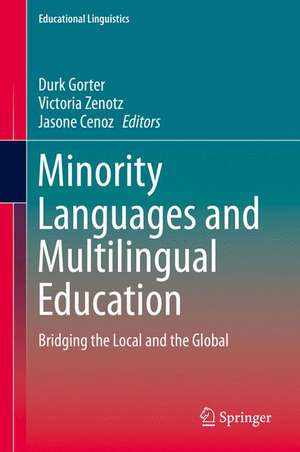Minority Languages and Multilingual Education: Bridging the Local and the Global: Educational Linguistics, cartea 18
Editat de Durk Gorter, Victoria Zenotz, Jasone Cenozen Limba Engleză Hardback – 18 noi 2013
| Toate formatele și edițiile | Preț | Express |
|---|---|---|
| Paperback (1) | 637.28 lei 6-8 săpt. | |
| SPRINGER NETHERLANDS – 23 aug 2016 | 637.28 lei 6-8 săpt. | |
| Hardback (1) | 643.48 lei 6-8 săpt. | |
| SPRINGER NETHERLANDS – 18 noi 2013 | 643.48 lei 6-8 săpt. |
Din seria Educational Linguistics
- 18%
 Preț: 959.98 lei
Preț: 959.98 lei - 15%
 Preț: 644.95 lei
Preț: 644.95 lei - 20%
 Preț: 495.50 lei
Preț: 495.50 lei - 18%
 Preț: 952.26 lei
Preț: 952.26 lei - 15%
 Preț: 649.87 lei
Preț: 649.87 lei - 18%
 Preț: 888.18 lei
Preț: 888.18 lei - 15%
 Preț: 644.95 lei
Preț: 644.95 lei - 15%
 Preț: 636.80 lei
Preț: 636.80 lei - 15%
 Preț: 634.49 lei
Preț: 634.49 lei - 20%
 Preț: 555.53 lei
Preț: 555.53 lei - 18%
 Preț: 940.72 lei
Preț: 940.72 lei - 20%
 Preț: 563.98 lei
Preț: 563.98 lei - 15%
 Preț: 638.57 lei
Preț: 638.57 lei - 20%
 Preț: 568.44 lei
Preț: 568.44 lei - 15%
 Preț: 642.83 lei
Preț: 642.83 lei - 18%
 Preț: 899.52 lei
Preț: 899.52 lei - 15%
 Preț: 638.76 lei
Preț: 638.76 lei - 15%
 Preț: 649.06 lei
Preț: 649.06 lei - 15%
 Preț: 643.65 lei
Preț: 643.65 lei -
 Preț: 390.08 lei
Preț: 390.08 lei - 15%
 Preț: 645.28 lei
Preț: 645.28 lei -
 Preț: 393.52 lei
Preț: 393.52 lei - 15%
 Preț: 649.39 lei
Preț: 649.39 lei -
 Preț: 392.75 lei
Preț: 392.75 lei - 18%
 Preț: 897.65 lei
Preț: 897.65 lei -
 Preț: 393.13 lei
Preț: 393.13 lei - 18%
 Preț: 728.28 lei
Preț: 728.28 lei - 15%
 Preț: 638.43 lei
Preț: 638.43 lei - 18%
 Preț: 1113.39 lei
Preț: 1113.39 lei
Preț: 643.48 lei
Preț vechi: 757.04 lei
-15% Nou
Puncte Express: 965
Preț estimativ în valută:
123.15€ • 128.09$ • 101.66£
123.15€ • 128.09$ • 101.66£
Carte tipărită la comandă
Livrare economică 15-29 aprilie
Preluare comenzi: 021 569.72.76
Specificații
ISBN-13: 9789400773165
ISBN-10: 9400773161
Pagini: 265
Ilustrații: XI, 220 p. 22 illus., 10 illus. in color.
Dimensiuni: 155 x 235 x 20 mm
Greutate: 0.5 kg
Ediția:2014
Editura: SPRINGER NETHERLANDS
Colecția Springer
Seria Educational Linguistics
Locul publicării:Dordrecht, Netherlands
ISBN-10: 9400773161
Pagini: 265
Ilustrații: XI, 220 p. 22 illus., 10 illus. in color.
Dimensiuni: 155 x 235 x 20 mm
Greutate: 0.5 kg
Ediția:2014
Editura: SPRINGER NETHERLANDS
Colecția Springer
Seria Educational Linguistics
Locul publicării:Dordrecht, Netherlands
Public țintă
ResearchCuprins
1 Introduction: minority language education facing major local and global challenges.- 2 Adopting a multilingual habitus: What North and South can learn from each other about the essential role of non-dominant languages in education.- 3 Model for trilingual education in the People’s Republic of China.- 4 Margins, diversity and achievement: System-wide data and implementation of multilingual education in Ethiopia.- 5 A new model of bilingualism for Singapore: Multilingualism in the 21st century.- 6 Language education and Canada’s Indigenous peoples.- 7 Policy and teaching English to Palestinian students in Israel: An ecological perspective to language education policies.- 8 Interethnic understanding and the teaching of local languages in Sri Lanka.- 9 Dynamic multimodal language practices in multilingual indigenous Sámi classrooms in Finland.- 10 Balancing the languages in Māori-medium education in Aotearoa/New Zealand.- 11 Critical classroom practices: Using “English” to foster minoritized languages and cultures in Oaxaca, Mexico.- 12 Multilingualism and European minority languages: The case of Basque.
Textul de pe ultima copertă
This book presents research on the situation minority language schoolchildren face when they need to learn languages of international communication, in particular English. The book takes minority languages as a starting point and it bridges local and global perspectives in the analysis of multilingual education contexts. It examines the interaction of minority languages and cultures, majority languages and lingua franca-s in a variety of settings across different regions and countries on all continents. Even though all chapters in this book involve minority languages, the issues discussed are relevant to any context in which more than language is used in education.
The book reveals challenges and opportunities of multilingual education by discussing issues such as Northern and Southern concepts, language education policies, language diversity, interethnic understanding, multimodal language practices, power, conflict, identity and prestige, among many others.
“This is the volume that finally accounts for multilingual education from a truly multilingual perspective by involving proposals and research from a variety of multilingual speech communities in the world. The (linguistically) rich Ethiopia and Mexico can teach the poor Europe and other Northern countries about multilingual education. CLIL promoters may learn from Finnish Sámi and Canadian Innu and Mi’gmaq indigenous communities as well as from Basque results. Speakers and teachers of minority and international languages will certainly be glad to hear the news. There is no need for a monolingual bias or tunnel vision in acquiring English in non-English speaking communities. This volume includes new challenging pedagogical perspectives while pointing to interesting conclusions for worldwide educational authorities”. Maria Pilar Safont Jordà, Universitat Jaume I, Castelló, Spain
The book reveals challenges and opportunities of multilingual education by discussing issues such as Northern and Southern concepts, language education policies, language diversity, interethnic understanding, multimodal language practices, power, conflict, identity and prestige, among many others.
“This is the volume that finally accounts for multilingual education from a truly multilingual perspective by involving proposals and research from a variety of multilingual speech communities in the world. The (linguistically) rich Ethiopia and Mexico can teach the poor Europe and other Northern countries about multilingual education. CLIL promoters may learn from Finnish Sámi and Canadian Innu and Mi’gmaq indigenous communities as well as from Basque results. Speakers and teachers of minority and international languages will certainly be glad to hear the news. There is no need for a monolingual bias or tunnel vision in acquiring English in non-English speaking communities. This volume includes new challenging pedagogical perspectives while pointing to interesting conclusions for worldwide educational authorities”. Maria Pilar Safont Jordà, Universitat Jaume I, Castelló, Spain
Caracteristici
Minority languages are related to other languages for the broadest possible scope Articles focus on previously understudied groups and their educational situation: Palestinians in Israel, Ethiopia, Mexican indigenous multilingualism Teaching minority languages is presented in its relation to the use of new technologies













